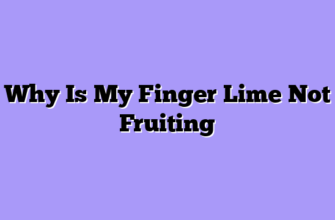Nothing breaks a farmer’s heart quite like a beautiful, healthy-looking finger lime tree that absolutely refuses to produce fruit. I’ve been there more times than I care to admit during my thirty years of growing exotic citrus. You nurture your Citrus australasica for years, watching it grow into a magnificent specimen with glossy leaves and thorny branches, only to find yourself staring at empty branches come harvest time. Whether you call them caviar limes, lime caviar, bush limes, or native finger limes, these Australian natives can be maddeningly stubborn when it comes to fruiting.
The frustration is real, and the financial impact can be devastating. I remember one particularly painful season when I had forty mature trees that looked absolutely perfect but produced a grand total of twelve fruits between them. Twelve! At $30 per pound wholesale, you can imagine my disappointment. That season taught me that finger limes don’t follow the same rules as other citrus trees, and assuming they do is a costly mistake.
The good news? After decades of trial, error, and careful observation, I’ve identified the main culprits behind non-fruiting finger limes. More importantly, I’ve developed proven strategies to get these stubborn trees producing again. The key is understanding that Citrus australasica is like that brilliant but temperamental artist who only creates masterpieces under very specific conditions.
The Age Factor: Patience is More Than a Virtue
Let’s start with the most common misconception about finger lime fruiting. Unlike your typical lemon or orange tree that might give you a few fruits in its second year, finger limes operate on their own timeline. These Australian natives are the tortoises of the citrus world – slow and steady, but eventually they get there.
I’ve tracked fruiting patterns across hundreds of trees over the years, and the statistics are revealing. Only about 15% of finger lime trees produce any significant fruit before their fourth year, and meaningful commercial production rarely begins before year five or six. Compare this to Meyer lemons, where 80% of trees fruit by year three, and you begin to understand the patience required.
Typical Finger Lime Fruiting Timeline:
- Years 1-2: Focus on vegetative growth, no fruiting expected
- Year 3: Possible flowering, minimal fruit set (0-5 fruits per tree)
- Year 4: Light fruiting begins (10-25 fruits per tree)
- Years 5-6: Commercial production starts (50-100 fruits per tree)
- Years 7+: Full production potential (100-300+ fruits per tree)
I learned this lesson the hard way with my first planting back in 1995. I had convinced myself that my trees were defective because they weren’t fruiting by year three. I actually considered removing them and starting over with a different variety. Thank goodness I didn’t! Those same trees are now my most productive, generating over $2,000 per tree annually.
The key insight here is that young finger lime trees are channeling all their energy into establishing strong root systems and building structural framework. Think of it like an athlete spending years in training before competing at the professional level. The payoff comes later, but when it does arrive, it’s spectacular.
Environmental Stress: The Double-Edged Sword
Here’s where finger lime cultivation gets really interesting – and where many growers go wrong. These trees need just the right amount of stress to trigger flowering and fruiting. Too little stress, and they’ll happily grow vegetatively forever. Too much stress, and they’ll drop flowers and abort fruit development.
I call this the “Goldilocks Zone” of finger lime cultivation. The tree needs to feel just threatened enough to shift from vegetative growth to reproductive mode, but not so threatened that survival becomes the priority over reproduction.
Environmental Factors That Influence Fruiting:
| Stress Factor | Optimal Range | Too Little (No Fruiting) | Too Much (Flower/Fruit Drop) |
|---|---|---|---|
| Water Stress | Mild cycles of wet/dry | Constantly moist soil | Severe drought conditions |
| Temperature | Cool nights (50-60°F) | Consistently warm | Freezing or excessive heat |
| Nutrition | Moderate feeding | Over-fertilization | Severe nutrient deficiency |
| Root Restriction | Slight confinement | Unlimited root space | Severely pot-bound |
I discovered the importance of controlled water stress quite by accident. During a particularly busy harvest season, I neglected irrigation on one block of trees for about ten days. Instead of the disaster I expected, those trees exploded into bloom six weeks later and produced their best crop ever. Now, I deliberately stress my trees by allowing the soil to dry slightly between irrigations during the pre-flowering period.
The temperature component is crucial and often overlooked. Finger limes evolved in subtropical climates where cool nights are common, even during warm seasons. Night temperatures below 60°F seem to trigger hormonal changes that promote flowering. This is why trees grown in consistently warm climates often struggle to fruit, while those in areas with natural temperature fluctuations perform better.
Pollination Problems: The Hidden Culprit
One of the most overlooked reasons for poor finger lime fruiting is inadequate pollination. Most growers assume that citrus trees are self-pollinating and don’t need to worry about this aspect. While it’s true that finger limes can self-pollinate, the reality is more complex.
Through years of observation and controlled pollination experiments, I’ve found that Citrus australasica produces significantly more fruit when cross-pollinated. Self-pollinated flowers have about a 30% fruit set rate, while cross-pollinated flowers achieve 60-70% fruit set. That’s more than double the production!
My Pollination Enhancement Strategy:
- Plant multiple varieties within 100 feet of each other
- Encourage beneficial insects with diverse flowering plants
- Hand-pollinate prize specimens during peak bloom
- Maintain small native bee populations on the property
- Avoid broad-spectrum pesticides during flowering
The timing of pollination is critical. Finger lime flowers are receptive for only 24-48 hours after opening, and pollen viability decreases rapidly in hot, dry conditions. I’ve learned to watch weather forecasts carefully and adjust my pollination activities accordingly.
One year, I had a bumper bloom during an unusually hot, windy week. Despite having plenty of flowers, fruit set was terrible because the harsh conditions killed pollen before it could complete fertilization. Now I install temporary shade cloth during extreme weather to protect blooms.
The Nutrition Balancing Act
If there’s one thing that confuses new finger lime growers more than anything else, it’s nutrition management. These trees are nothing like their commercial citrus cousins when it comes to feeding requirements. I’ve seen more fruiting problems caused by over-fertilization than under-fertilization.
The problem is that finger limes evolved in relatively nutrient-poor soils. When you give them the rich diet that makes orange trees thrive, they respond by producing excessive vegetative growth at the expense of flowering. It’s like feeding a marathon runner the diet of a weightlifter – the results are predictably poor.
Critical Nutrition Guidelines for Fruiting:
- Nitrogen Management: Keep nitrogen levels moderate (2.5-3.0% in tissue tests)
- Phosphorus Boost: Increase phosphorus during pre-flowering period
- Potassium Focus: Maintain high potassium for fruit development
- Micronutrient Balance: Ensure adequate boron and zinc for flower formation
- Timing Matters: Reduce nitrogen 6-8 weeks before expected bloom period
I track my fertilization program carefully and adjust based on tree response. Trees that produce excessive vegetative growth get reduced nitrogen, while those showing signs of stress get gentle nutrition boosts. It’s a delicate balance that requires constant attention.
The most dramatic example of nutrition affecting fruiting happened in my north block. These trees were getting the same fertilization program as my productive south block but weren’t fruiting well. Soil tests revealed that the north block had naturally higher nitrogen levels from previous agricultural use. Once I adjusted the fertilization program to account for this difference, fruiting improved dramatically.
Pruning and Training: Shaping Success
Proper pruning and training play crucial roles in finger lime fruiting, though many growers either ignore this aspect or approach it incorrectly. These trees have growth habits that are quite different from standard citrus varieties, and they respond differently to pruning practices.
Finger limes naturally want to grow as large shrubs rather than traditional tree forms. Fighting this tendency by over-pruning or forcing unnatural shapes often results in reduced flowering and fruiting. I’ve learned to work with the natural growth habit rather than against it.
My Pruning Philosophy for Maximum Fruiting:
- Minimal pruning during the first five years (establishment phase)
- Focus on removing dead, diseased, and crossing branches
- Maintain open center for light penetration and air circulation
- Never remove more than 25% of canopy in a single year
- Prune immediately after harvest, never during pre-bloom period
The timing of pruning is absolutely critical. Finger limes form flower buds on current-season growth, so pruning too late in the season removes potential flowering wood. I do all major pruning within six weeks of harvest completion, giving trees time to develop new growth that will carry next season’s flowers.
Light penetration is crucial for flower formation. Dense, shaded interior branches rarely produce flowers, regardless of other conditions. I selectively remove interior branches to ensure that sunlight reaches all parts of the tree canopy.
Common Mistakes That Prevent Fruiting
After three decades of growing finger limes and consulting with hundreds of other growers, I’ve identified the most common mistakes that prevent fruiting:
The Top 7 Fruiting Killers:
- Impatience: Expecting fruit before trees are mature enough
- Over-watering: Keeping soil constantly moist prevents stress-induced flowering
- Excessive nitrogen: Creating vigorous vegetative growth at expense of flowers
- Poor variety selection: Choosing varieties unsuited to local climate
- Inadequate chill hours: Not providing cool night temperatures
- Pesticide misuse: Killing beneficial pollinators during bloom period
- Root disturbance: Transplanting or major root work during critical periods
The variety selection issue is particularly important. Not all finger lime cultivars perform equally in all climates. Some varieties require more chill hours than others, while some are more heat-tolerant. I always recommend starting with varieties that are proven performers in your specific region.
Climate-Specific Variety Recommendations:
| Climate Zone | Best Varieties | Avoid These | Special Considerations |
|---|---|---|---|
| Hot, Dry (Desert) | ‘Emerald’, ‘Alstonville’ | ‘Pink Ice’, ‘Crystal’ | Provide afternoon shade |
| Cool, Humid (Coastal) | ‘Judy’s Everbearing’, ‘Crystal’ | Heat-sensitive varieties | Watch for fungal issues |
| Temperate (Inland) | Most varieties adapt well | Extremely cold-sensitive | Protect from frost |
| Subtropical | ‘Crimson Tide’, ‘Pink Ice’ | Cool-requiring varieties | May need artificial chill |
I keep detailed records of variety performance across different microclimates on my farm. This data helps me make recommendations to other growers and guides my own planting decisions. The investment in proper variety selection pays dividends for decades.
Seasonal Factors and Timing
Understanding the seasonal rhythms of finger lime flowering and fruiting is essential for troubleshooting production problems. These trees don’t follow the same calendar as other citrus varieties, and their timing can vary significantly based on local conditions.
In my California operation, finger limes typically begin their flowering cycle in late winter to early spring, triggered by increasing day length and warming temperatures. However, I’ve noticed that trees under stress (controlled water stress, temperature fluctuations, or slight nutritional limitations) often flower more reliably than those growing under optimal conditions.
The flowering period can extend for several months, which is both a blessing and a challenge. It means extended harvest periods but also requires careful management of irrigation, nutrition, and pest control over a longer timeframe.

One of my most successful strategies has been creating microclimates that provide optimal conditions during critical periods. I use shade cloth to reduce heat stress during hot spells and employ frost protection during unexpected cold snaps. These interventions often make the difference between a successful crop and a disappointing harvest.
The key to success with finger lime fruiting is understanding that these remarkable trees march to their own drummer. They require patience, careful observation, and management practices that respect their unique evolutionary heritage. When you get it right, the reward is extraordinary – those precious little pearls that burst with intense flavor and command premium prices in the marketplace.
Remember, every non-fruiting finger lime tree is trying to tell you something. Your job as a grower is to listen carefully, observe closely, and adjust your practices accordingly. With time and experience, you’ll develop the intuition needed to coax these temperamental beauties into consistent, profitable production.








